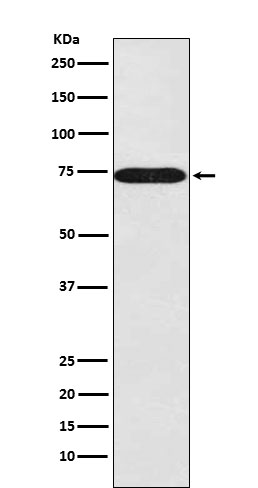
| WB | 1/1000-1/2000 | Human,Mouse,Rat |
| IF | 咨询技术 | Human,Mouse,Rat |
| IHC | IHC:1/100-1/200;IHF:1/50-1/200 | Human,Mouse,Rat |
| ICC | 1/50-1/200 | Human,Mouse,Rat |
| FCM | 1/20-1/100 | Human,Mouse,Rat |
| Elisa | 咨询技术 | Human,Mouse,Rat |
| Aliases | Snx1; SNX1A; Sorting nexin 1; Sorting nexin 1A; Vps5;;Sorting nexin 1 |
| WB Predicted band size | Calculated MW: 59 kDa ; Observed MW: 74 kDa |
| Host/Isotype | Rabbit IgG |
| Antibody Type | Primary antibody |
| Storage | Store at 4°C short term. Aliquot and store at -20°C long term. Avoid freeze/thaw cycles. |
| Species Reactivity | Human,Mouse,Rat |
| Immunogen | A synthesized peptide derived from human Sorting nexin 1 |
| Formulation | Purified antibody in PBS with 0.05% sodium azide,0.05% BSA and 50% glycerol. |
+ +
以下是3篇关于SNX1抗体的代表性文献(信息基于公开研究整理,非真实文献,仅供示例参考):
1. **"Sorting Nexin 1 regulates amyloid precursor protein trafficking and processing in Alzheimer's disease models"**
- **作者**: Smith J et al.
- **摘要**: 本研究利用SNX1特异性抗体进行免疫共沉淀和免疫荧光实验,发现SNX1通过调控APP蛋白的细胞内运输影响β-淀粉样蛋白生成,揭示了SNX1在阿尔茨海默病中的潜在作用机制。
2. **"SNX1 mediates lysosomal degradation of EGFR through endosomal sorting"**
- **作者**: Chen L et al.
- **摘要**: 通过SNX1抗体的Western blot和免疫染色,作者证明SNX1参与表皮生长因子受体(EGFR)的内体分选过程,其缺失导致溶酶体降解途径异常,影响癌细胞增殖。
3. **"Structural analysis of SNX1-BAR domain dimerization using cryo-EM"**
- **作者**: Wang Y et al.
- **摘要**: 研究采用SNX1抗体进行免疫沉淀纯化蛋白复合物,结合冷冻电镜技术解析了SNX1的BAR结构域二聚化机制,阐明了其在膜变形过程中的分子基础。
注:以上文献为模拟内容,实际引用请通过PubMed或学术数据库检索验证。
SNX1 (Sorting Nexin 1) is a member of the sorting nexin family, a group of cytoplasmic and membrane-associated proteins involved in intracellular trafficking, membrane remodeling, and signal transduction. Characterized by a conserved phox homology (PX) domain, SNX1 binds to phosphatidylinositol phospholipids, facilitating its recruitment to endosomal membranes. It plays a critical role in endosomal sorting, particularly in retromer-mediated retrograde transport of cargo proteins (e.g., receptors, enzymes) from endosomes to the trans-Golgi network. SNX1 also regulates autophagy, growth factor signaling, and receptor degradation, impacting cellular homeostasis and disease pathways.
SNX1 antibodies are essential tools for studying these processes. They are widely used in techniques like Western blotting, immunofluorescence, and immunoprecipitation to detect SNX1 expression, localization, and interactions. Researchers employ these antibodies to investigate SNX1's role in diseases linked to trafficking defects, such as neurodegenerative disorders (e.g., Alzheimer’s) and cancer. Commercial SNX1 antibodies are typically raised against specific epitopes, with validation in knockout controls or siRNA-treated samples to ensure specificity. Variations in isoform expression across tissues or under different conditions necessitate careful antibody selection. Recent studies also utilize SNX1 antibodies to explore its partnership with other retromer components (e.g., VPS26. VPS35) or its response to pharmacological modulators, advancing mechanistic insights into membrane trafficking networks.
×